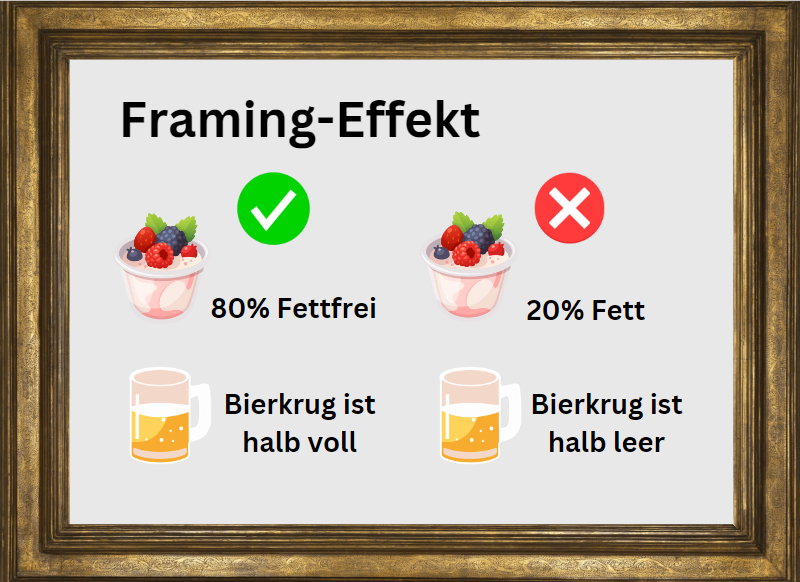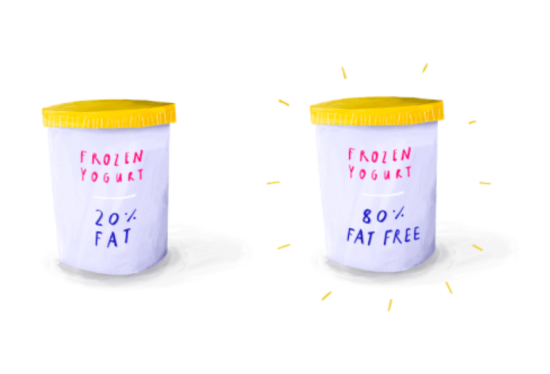
The framing effect, a widely used concept in psychology and marketing, plays a crucial role in our perception and decision-making.
This article aims to explain this phenomenon in detail and illustrate its application in various contexts.

Definition of the framing effect
The framing effect is a term from cognitive psychology that describes the tendency to respond differently to a given piece of information based on its presentation or "framing." In other words, the way information is presented can strongly influence our decisions and perceptions.
This phenomenon has been extensively researched by psychologists Daniel Kahneman and Amos Tversky and is now a central concept in many psychological and economic studies.
Examples of the framing effect
The framing effect is present in many aspects of our lives, from politics to marketing, and even in our daily lives. For example, the way political messages are framed and presented can significantly influence public opinion. In marketing, the framing of product information and offers can significantly influence customers' buying decisions.
A classic example of the framing effect is the presentation of discounts: A product can be presented as either "20% discount" or "80% of original price". Although both statements represent the same price, the first presentation may seem more attractive as it emphasizes a financial gain.

Framing effect in marketing communication
In marketing communications, the framing effect is a powerful tool for influencing customer decisions. By strategically framing product information, offers or sales pitches, marketers can influence customers' perceptions of the value of a product or service. This can help increase sales, improve brand image, or increase customer loyalty.
Framing effect in digital marketing
In digital marketing, the framing effect offers many opportunities to optimize the communication strategy. In email marketing, social media or web design, clever framing of information and offers can improve the user experience, increase engagement and ultimately boost sales. However, it is important to make sure that framing always matches the values and expectations of the target audience to maintain customer trust and satisfaction.
Email marketing: By framing offers and news in emails, for example, by using positive words or highlighting exclusive benefits, you can increase the likelihood that recipients will open your emails, read through them, and ultimately click on the call-to-action.
Social media: The framing effect can be used on social media platforms to increase response and engagement. By designing posts and ads that evoke positive emotions or highlight the benefits of a product or service, you can get more likes, shares, and comments.
Web design: You can also use the framing effect on your website to influence user behavior. For example, price information can be framed in such a way that it is perceived as particularly favorable or as good value for money. Testimonials and customer reviews can also be used strategically to create positive framing.
It's always important to monitor the reactions of your target audience and adjust the framing accordingly. The goal is to create a win-win situation where both your company and your customers benefit.
Strategies for using the framing effect
Proper use of the framing effect requires strategic thinking and an intimate knowledge of the target audience. Here are some tips on how to use the framing effect effectively:
- Understand your target audience: Framing should always be tailored to the specific needs, values and expectations of your target audience.
- Use positive framing techniques: People usually respond more strongly to positive messages than to negative ones. Therefore, try to formulate your messages in a way that emphasizes positive aspects.
- Stay consistent: Make sure your framing is consistent with your brand identity and overall messaging.
- Test and optimize: As with any marketing strategy, it's important to test different framing approaches and tweak your strategy based on the results you get.
Case studies: Successful application of the framing effect
There are many successful examples of the framing effect in action. One prominent example is the "Subway" campaign, which presented fast food as a healthy option by highlighting stories of people who had lost weight by eating Subway products. Another notable use occurred in politics when Barack Obama referred to his health care reform as "health care" rather than "health insurance" to highlight the benefits of the program.
Summary and conclusion
The framing effect is a powerful phenomenon that plays a role in many areas of our lives, from politics to marketing. By strategically framing information, we can influence people's perceptions and decisions.
Therefore, it is important to understand the concept of the framing effect and to use it in a responsible and effective way. In the future, we are likely to see more innovative applications of the framing effect as more and more fields recognize the importance of cognitive psychology in influencing decisions.
